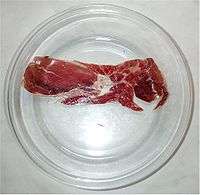Jamón
Jamón (Spanish pronunciation: [xaˈmon], pl. jamones) is the Spanish word for ham. In English it refers to certain types of dry-cured ham from Spain. There are two primary commercial labels for jamón: jamón ibérico (ham from the Black Iberian pig), and jamón serrano (meaning ham from the sierra or mountain range), which includes most other varieties.
Jamón production is similar to that of Portuguese presunto and to Italian prosciutto but it is typically cured for longer (up to 18 months).
Regionally; in Spain jamón is also known as pernil (in Aragon, Catalonia, Valencia, and other areas of Eastern Spain), xamón (in Galicia) and urdaiazpiko (in the Basque Country and Navarre).
A similar product is the paleta de cerdo or paletilla, which is made from the front leg of a pig, instead of the hind leg used for jamón.
Types

The major legal categories of dry-cured uncooked ham are as follows:
- Jamón ibérico de bellota (also known as jamón ibérico de Montanera): from free-range bred Iberian pigs, which feed mainly on acorn during the season
- now no longer a category, Jamón ibérico de recebo: from acorn, pasture and compound-fed Iberian pigs
- Jamón ibérico de cebo o campo (field). from Iberian pigs feeding natural feed and in the case of field, grazes in the fields during a period of 2 months.
- Jamón ibérico: (was also known as jamón de pata negra, but use of this name was prohibited on April 15, 2006 in order to avoid confusion). Compound-fed Iberian pigs.
- Jamón serrano: (also known as jamón reserva, jamón curado and jamón extra): “ordinary cured ham” from white pigs, fed with a mixed diet of authorized commercial compound feed. The words serrano, curado, reserva and extra are just marketing terms and do not reliably indicate quality, which can differ markedly between different brands and is not easy to recognize. Price may be a good indication. It has TSG status.
Spanish jamones are covered by European law with PDO or PGI:
- Jamón de Los Pedroches has PDO status.
- Jamón Dehesa de Extremadura has PDO status.
- Jamón de Guijuelo has PDO status.
- Jamón de Huelva has PDO status.
- Jamón de Teruel has PDO status.
- Jamón de Trevélez has PGI status.
- A final ham-type product to be covered with a geographical indication is: Lacón gallego, which has PGI status.
Jamón may also be smoked in some regions and it is consumed for personal use. This is common in the southern area of Castile and León as well as parts of Extremadura. Such a jamón has a harder texture and smoky-salty flavour.
See also
References
External links
| Wikimedia Commons has media related to Jamón. |
- Qué precio tiene una pieza de jamón ibérico